Skiing comes to the “Maryland Alps” in 1940
By Francis “Champ” Zumbrun
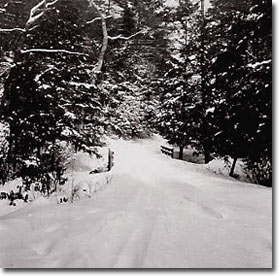 Newspaper reporters in the 1940’s and 1950’s called this area “The
Maryland Alps,” the place where winter was king - “Maryland’s first genuine
winter sports area.” Can you identify this place?
Newspaper reporters in the 1940’s and 1950’s called this area “The
Maryland Alps,” the place where winter was king - “Maryland’s first genuine
winter sports area.” Can you identify this place?
Here are a few more clues: “The first ski event south of the Mason and Dixon
Line”, occurred here in 1941. In the 1950’s, this locale was called Maryland’s
skiing mecca.” Give up?
These accolades refer to present day New Germany State Park and Savage River State
Forest, where in 1940, recreational skiing was as new and fresh as the first
snowfall of that winter.
Skiing originated more than 5,000 years ago in Scandinavian countries, so
why did it take so long for the sport of skiing to come to Maryland? In
countries like Norway and Switzerland, skiing first developed as a means for
transportation, hunting, working, exploring, and conducting warfare. It has
been only recently that skiing evolved into a popular winter recreational
activity.
In the United States, the first ski club was formed in 1872, and the
National Ski Association was organized in 1904. In1936, at the winter Olympic
games in Austria, the alpine ski event was introduced for the first time and
added to the established slalom event. It seems that soon after the winter
Olympic games, the sport of skiing in the United States exploded in
popularity.
.jpg) The timing of the growing popularity of recreational skiing couldn’t have been
better for Fred W. Besley, Maryland’s legendary first state forester. During
his administration from 1906-1942, Maryland’s state forests and parks grew
from zero acres to more than 100,000 acres. By 1940, Garrett County had more
than half of the State’s public lands, with about 50,000 acres of state
forests.
The timing of the growing popularity of recreational skiing couldn’t have been
better for Fred W. Besley, Maryland’s legendary first state forester. During
his administration from 1906-1942, Maryland’s state forests and parks grew
from zero acres to more than 100,000 acres. By 1940, Garrett County had more
than half of the State’s public lands, with about 50,000 acres of state
forests.
In Maryland, Besley pioneered the concept of linking scientific forestry
with outdoor recreation. He was always looking for ways to gain public support
and funding for forestry conservation and acquisition of additional lands. He
believed that by promoting outdoor recreation on public lands, the public
would be more likely to support the State in their efforts to purchase
additional lands to practice scientific forestry.
Fred W. Besley’s daughter, Helen Besley Overington, told me: “Father
believed that forests should not only be conserved, but that they should be
used… [He] was very interested in getting the public to use the land… [He]
thought this would bring more public support for conservation.”
A well-known summer resort, Garrett County was visited by thousands of
campers, hunters, and other outdoor enthusiasts each year. However, in winter
it was a different story - visitors were rarely seen. Folks that lived in the
area had a saying, “when the mercury slid down the cider hole, the natives
hibernated.” Besley believed that skiing would provide outdoor recreational
opportunities to bring more winter visitors to Garrett County and thereby help
the local economy.
Beginning around 1938, a number of different organizations began writing
letters to Besley and other state officials requesting a place to ski in
Maryland. Letters came from ski clubs in Cumberland, Baltimore, and
Washington. Requests also came from members of the Maryland Mountain Club and
the Western Maryland Ski Club led by Dr. and Mrs. Royce Hodges, and Graydon
“Ace” Dunlap from Cumberland. Henry C. Buckingham, the district forester in
western Maryland for the State Forestry Department, reported that requests
were piling up on his desk in Cumberland to develop a skiing center.
Construction of the Ski Resort Begins
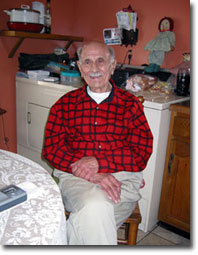 I had the opportunity to meet and interview Joe Davis, one of the foresters
who helped construct the ski slopes in Garrett County. In 1938, Besley asked
Davis, a forester at a Civilian Conservation Corps camp S-57 at Fishing Creek
near Gambrill State Park in Frederick, Maryland to transfer to Garrett County.
Davis told me about the day Besley called him down to his office at the
Fidelity building on Charles Street in Baltimore to discuss this matter in
person.
I had the opportunity to meet and interview Joe Davis, one of the foresters
who helped construct the ski slopes in Garrett County. In 1938, Besley asked
Davis, a forester at a Civilian Conservation Corps camp S-57 at Fishing Creek
near Gambrill State Park in Frederick, Maryland to transfer to Garrett County.
Davis told me about the day Besley called him down to his office at the
Fidelity building on Charles Street in Baltimore to discuss this matter in
person.
Besley said to Joe, “Davis, you have done a good job at the Gambrill
watershed. I know you just got married, but we need you at Meadow Mountain.
It’s the largest state forest and we would like to have you there.”
Davis replied: “O.K. Mr. Besley!” Joe told me that his visit with Mr.
Besley was “a command performance.” He went home and discussed it with his new
bride, and soon thereafter, they moved to Garrett County.
By 1939, the Civilian Conservation Corps buildings were abandoned at New
Germany. That same year, Buckingham brought two consultants to New Germany
State Park to meet with Joe Davis and Mathew E. Martin, the Superintendent of Savage River
State Forest, to discuss building a skiing area.
As it turned out, Buckingham, Martin, and Davis were the primary field
people involved in developing the ski resort. They planned and oversaw the
construction of three different types of ski areas at New Germany State Park
and Savage River State Forest between the years 1939-1941: a beginner's slalom
ski course, an expert's alpine downhill ski trail, and an endurance-based
cross-country ski course.
Davis told me, “One consultant was Charles Effinger Smoot, a Dartmouth
graduate and lawyer in Washington. He was quite an outdoorsman. The other was
Frank Ballard who came from the Department of the Interior.”
Davis continued, “At this meeting, they talked about 'ski touring' where we
would construct ski trails so skiers could tour them. They also talked about
building a slalom course on the hillside overlooking New Germany Lake. That
particular parcel of land was owned by Sam Otto.” Mr. Otto was a neighboring
farmer at New Germany who supported the State Forestry conservation programs.
The consultants and Buckingham then talked about building an expert ski
course. Before the consultants left, Davis humbly asked them: “Gentlemen, is
there a book or a pamphlet that I could read to get a vicarious feeling about
this skiing?” Davis admitted he had little experience as a skier. He came from
a part of New York State where the land was flat. “The little skiing I did as
a kid was on barrel staves,” he explained.
Davis continued his story: “Smoot looked up at me after my question and
said, 'Joe, the best pamphlet you can find on the subject would be the Boy
Scout merit badge pamphlet on skiing.'
Buckingham’s parting words when the meeting ended was: "Now Davis, don’t build
that trail too wide! Erosion you know." Davis replied back, "Yes sir, Mr.
Buckingham!"
“So I dashed down to Cumberland to the Boy Scout Council office and I
bought a brown-covered merit badge pamphlet on skiing,” Joe explained. “I read
it. I used it to learn about skiing.”
Davis continued talking about the challenges of building the expert ski
course: “The concept Mr. Buckingham and I both had was to just cut a straight
line from the top of the mountain down to Savage River. After reading the Boy
Scout merit badge pamphlet, I got the feeling that our original concept was
wrong.”
 “The expert trail was not a straight shoot down the mountain," Joe
explained. “It wound down like a snake.” This ski slope became ‘the Whiskey
Hollow Ski Trail,’ located about four miles from New Germany Lake on Meadow
Mountain, a ridge that rises 2,800 feet above sea level. When complete, the expert ski course
dropped 800 feet over a distance of 3,300 feet, with
turning pitches of 30-35 degrees.
“The expert trail was not a straight shoot down the mountain," Joe
explained. “It wound down like a snake.” This ski slope became ‘the Whiskey
Hollow Ski Trail,’ located about four miles from New Germany Lake on Meadow
Mountain, a ridge that rises 2,800 feet above sea level. When complete, the expert ski course
dropped 800 feet over a distance of 3,300 feet, with
turning pitches of 30-35 degrees.
“The building of the expert course had me down on my knees praying for
divine guidance,” Joe said. “I did find an area that had the best exposure, where snow seemed to lie the longest in the winter. I had walked up and down
that mountainside a dozen times until I found the exact location where I wanted to
start working.”
Joe explained, “There was a woods road on top that went out about 50 yards.
From there I ran a string line through the rhododendron and hemlock down to
the bottom and we began clearing, removing stumps and everything. I didn’t use
a transit or compass.” Members of the Civilian Conservation Corps and
Washington Ski Club helped Davis build the Whiskey Hollow trail ski slope in
the summer of 1939.
“Of course, Buckingham told me not to build the trail too wide, so at the
curves it was almost 50 yards at the turn-around.”
“I realized after we cleared the slopes at the curves that if there was a
low snow-pack, skiers would wear it down to bare soil where there were
pebbles, rocks, and so on. The pastureland along Savage River had been
pastured for decades, so we cut sod there, and sodded all the curves of the
trail.”
Offutt Johnson, retired employee of the Maryland Park Service and Program
Open Space program, told me his impressions of the Whiskey Hollow Trail: “My
Dad took me to see the Whiskey Hollow Ski trail when I was about 14. It would
have been around 1955. The trail would have been 15 years old and it looked
fantastic! My first reaction was WOW! There is just no way people can ski down
that! That trail was a real gem!”
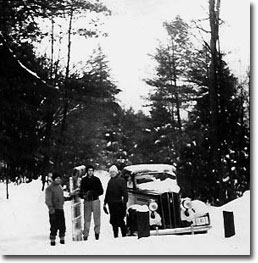 “It really was beautiful! This serpentine trail cutting through the wooded
slope of the mountain was softened by green sod,” Offutt continued. “The
borders of the trail were defined by a lush border of rhododendron and
Canadian hemlock. Just the site of it conveyed the promise of an exhilarating
outdoor experience, no matter what the season.”
“It really was beautiful! This serpentine trail cutting through the wooded
slope of the mountain was softened by green sod,” Offutt continued. “The
borders of the trail were defined by a lush border of rhododendron and
Canadian hemlock. Just the site of it conveyed the promise of an exhilarating
outdoor experience, no matter what the season.”
The design and construction of the slalom and the ski touring trail were
less challenging in contrast to the Whiskey Hollow expert course. The slalom
course was located next to New Germany Lake on 30-acres of the Sam Otto and Floyd
Broadwater farms. Both of these farmers cooperated and supported the
Forestry Department’s efforts to bring skiing to Maryland and agreed to open
up their land in the winter to the public. Under Mathew Martin’s supervision,
a crew from the National Youth Administration opened these fields by removing
rocks, stumps, and fencing. The gentle slopes on Otto’ s farm were ideal for
beginning skiers.
The ski-touring cross-country ski trail that was developed followed a
4-mile course along Meadow Mountain that varied in width from 30 to 50 feet.
The Ski Resort Opens to the Public
.jpg) On the first weekend of January 1940, the ski resort informally opened with
about 200 people present. Appropriately, Henry C. Buckingham, District
Forester, and Mathew E. Martin, Superintendent of Savage River State Forest,
were present to greet the crowd. A reporter from the Baltimore Sun covered
this event for the newspaper.
On the first weekend of January 1940, the ski resort informally opened with
about 200 people present. Appropriately, Henry C. Buckingham, District
Forester, and Mathew E. Martin, Superintendent of Savage River State Forest,
were present to greet the crowd. A reporter from the Baltimore Sun covered
this event for the newspaper.
In addition to praising the efforts of the Maryland Forestry Department for
bringing skiing to Maryland, the reporter noted comments made by Mr. Martin
about one memorable Garrett County winter storm that had occurred several
years earlier in 1936. Martin recalled, “snow drifts so deep that the
telephone poles were invisible and a temperature that occasionally hung around
36 below.” Indeed, winter was truly king in Garrett County.
One year later in 1941 on February 22nd and 23rd, the first ski event held
south of the Mason and Dixon line took place at New Germany State Park and
Savage River State Forest. About sixty skiers participated and 300 spectators
were present to cheer on the skiers. Reporters from the Washington Post and
Baltimore Sun newspapers were also there.
 In a way, this was an international meet as some of the more skilled and
experience skiers present were natives from Germany and other Scandinavian
countries. People came from Cumberland, Washington, Baltimore, and Pittsburgh.
This was a notable crowd in those days. Back then, depending on the weather,
the drive from Washington and Baltimore could take from seven to ten hours over
two-lane roads.
In a way, this was an international meet as some of the more skilled and
experience skiers present were natives from Germany and other Scandinavian
countries. People came from Cumberland, Washington, Baltimore, and Pittsburgh.
This was a notable crowd in those days. Back then, depending on the weather,
the drive from Washington and Baltimore could take from seven to ten hours over
two-lane roads.
The temperatures that weekend ranged from zero to fifteen degrees and the
snow conditions were ideal. Joe Davis remembered, “They set up a slalom course
and a downhill race. “There was a skier named Jones from Baltimore who made it
down in 48 seconds!”
“There was a Norwegian girl, Ann Marie Nunn, from the Norwegian embassy,”
Joe recalled. “I can still remember her. She was tall and had a white ski
outfit. She looked beautiful in that outfit. She made it down the slope in 52
seconds!”
Many photographs taken of the events that weekend still survive. Buckingham
served that day as timekeeper at the finish line at the alpine event on the
Whiskey Hollow Trail. A photograph shows him holding a stopwatch in each hand,
standing at the finish line next to a telephone mounted on a pole. With the
telephone, Buckingham could communicate to officials on top of the hill at the
start line.
.jpg)
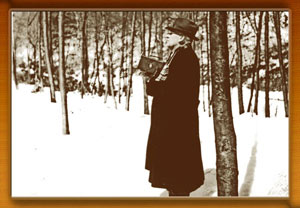
Another photograph taken that weekend shows Fred Besley standing quietly on the
sidelines as a spectator. Wearing a long winter overcoat, scarf, and hat, the
photograph shows Mr. Besley holding a camera, apparently documenting the
event with photographs for posterity.
New Germany State Park and
Savage River
State Forest Ski Resort (1940-1960)
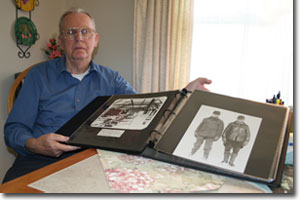 Local youth took a big interest in skiing. Although many of them couldn’t afford
the cost for new skis, that didn’t stop them. How some of them
obtained their first skies shows Garrett County innovation and creativeness at
its best. Bill Martin, the son of Savage River superintendent Mathew Martin,
told me this story.
Local youth took a big interest in skiing. Although many of them couldn’t afford
the cost for new skis, that didn’t stop them. How some of them
obtained their first skies shows Garrett County innovation and creativeness at
its best. Bill Martin, the son of Savage River superintendent Mathew Martin,
told me this story.
“Many of our skis came from hickory bows that supported canvas covers on CCC transport trucks. We sawed the wooden bows off at the edges from the truck
and took the pieces to Mr. Swauger, a CCC carpenter and local barber. The
boards were built up so a foot strap could be placed through it. For binding,
we sometimes used leather harness straps; at other times we used springs from
the screen doors of the CCC camp. There were no grooves in them, but they were
fast enough.”
Mr. Swauger also made skis using an old ski for a pattern. Bill Martin
described how he made them: “We’d take to him hickory or ash boards, about
2-inches thick rough-cut and 3-inches wide. Mr. Swauger sanded the boards. He
then placed the boards in a boiling kettle all day. In a couple of hours the
boards became so pliable that they flapped when shaken. Next, he put the
boards in a form and then in a vise. He would place a weight on the end of the
board and get a perfect bend in it.”
On the Otto Farm, a ski rope tow was constructed, powered by 1935 dodge
pick-up truck. “The Resettlement Administration donated it to the State,” Bill
Martin told me. “The bed was taken off on the rear end and jacked up and a
drum was used on one wheel for the rope tow. A shack was built around the cab
of the vehicle. Heat from the engine warmed the interior of the shack,
providing some comfort for the operator.”
Apparently, the design of the Otto rope tow was very similar to the first
rope tow used in America in 1934 at Woodstock, Vermont. The original design,
like the one used at the Otto farm, also used an old automobile to power the
towing system, using a rope looped around a wheel rim.
“There was also a warming hut on the Otto farm,” Bill explained. “Kerosene was
used to heat the building and to cook. Soft drinks and snacks were available.
Loraine Otto and Bill Martin operated the business."
.jpg) “They bought hamburger meat for 29 cents per pound,” Bill continued. “Each
pound was divided into four burgers that sold for 20 cents each. For an extra
nickel you could get it topped with cheese and/or a fried egg. Who said
McDonalds made the first quarter pounder! Soft drinks were five cents and
coffee was free.”
“They bought hamburger meat for 29 cents per pound,” Bill continued. “Each
pound was divided into four burgers that sold for 20 cents each. For an extra
nickel you could get it topped with cheese and/or a fried egg. Who said
McDonalds made the first quarter pounder! Soft drinks were five cents and
coffee was free.”
“Whiskey Hollow was not a ski trail for beginners, as many skiers found out
too late,” Bill recalled. Since a motorized rope tow wasn’t available at
Whisky Hollow, a car shuttle service was offered. “Some skiers would pay 10
cents to be taken by car or pickup truck from the bottom of the trail back to
the top.” On several occasions, after a day’s work of
shuttling skiers, Bill recalls coming home with a pocketful of quarters, dimes, and nickels.
Construction of New Germany Road occurred sometime between the late 1950’s
and early 1960’s. The road signaled the demise of the slalom ski course on the
Otto farm as it cut right through the property.
Bill Martin thought that one of key things that
went against the long term survival of the ski resort at New Germany and
Savage River was that the nearest hotels were thirty miles away. In the
beginning, skiers stayed at the Martin House at New Germany for $1.50 per
night. “Most just threw their sleeping bags on the floor and crawled in.
People who came in groups such as this took their meals at a local farm house-
three meals for $2.00 a day,” Bill remembered.
 Ski courses were developed in the 1960’s at
nearby skiing resorts that offered improved facilities and amenities. Joe
Davis believed that “the advent of Wisp at Deep Creek Lake and its artificial
snow making capability” contributed to the decline in popularity at the New
Germany ski resort. In addition, another ski resort established near Davis,
West Virginia, where the snow was heavier also contributed to its disuse.
Ski courses were developed in the 1960’s at
nearby skiing resorts that offered improved facilities and amenities. Joe
Davis believed that “the advent of Wisp at Deep Creek Lake and its artificial
snow making capability” contributed to the decline in popularity at the New
Germany ski resort. In addition, another ski resort established near Davis,
West Virginia, where the snow was heavier also contributed to its disuse.
Nature slowly reclaimed the land where expert
skiers once demonstrated their skills on Maryland’s first developed ski
trails. Even so, the legacy and spirit of Maryland’s first ski resort, begun
in 1940, still continues at Savage River State Forest and New Germany State
Park. The original network of cross-country trails over the years has
expanded from the original 4-miles to about 12-miles. Tremendous backcountry
skiing and snowshoeing opportunities also are available at Savage River State
Forest.
Today, the ski resorts at Deep Creek Lake,
Maryland and near Davis, West Virginia bring skiers to the area in large
numbers. “However,” Joe Davis wrote in his autobiography, “the trail at New
Germany, built by the CCC for the State of Maryland, still has the distinction
of being the first.”
Acknowledgements:
Francis "Champ" Zumbrun is the forest manager at Green Ridge
State Forest. He has worked as a professional forester for DNR since 1978. He
serves on the Forestry and Parks Centennial Committee.
The author
would like to thank the following individuals for providing information for this
article: Joe Davis, Eric Creeter, Bill Martin, Offutt Johnson, Kirk Rodgers, Helen Besley Overington,
Larry Maxim, Mike Gregory, Robb Schoeberlein (Maryland State Archives), Ross
Kimmel, Robert Bailey, and Linda Wiley.
Photographs (top to bottom)
-
Poplar Lick Road, New Germany State Park, 1941
-
Spectators at cross-country ski race, 1941
-
Joe Davis was tapped by Fred Besley to create
ski slopes at New Germany in 1939
-
Whiskey Hollow Ski Trail, Savage State Forest,
1941
-
Ready for a day of winter sports, photo by
Proctor Rodgers
-
Crossing the finish line, Whiskey Hollow Ski
Trail, 1941
-
Bud Little, downhill champion, New Germany, Savage
River State Forest, Garrett County, 1941.
-
Miss Anne Marie Nunn skiing Otto's Slope, photo
by Proctor Rodgers
-
Timekeeper H.C. Buckingham (Maryland's 3rd State
Forester) phoning in results from finish line. 1941
-
Fred W. Besley with his camera at New Germany,
1941
-
Bill Martin, son of Savage River State Forest
superintendent Mathew Martin, with his scrapbook of Maryland State Forest & Park
history.
-
Unloading for a good ski run, 1941
-
Cross Country Skier at New Germany - 2007, photo
courtesy of Jeff Coates